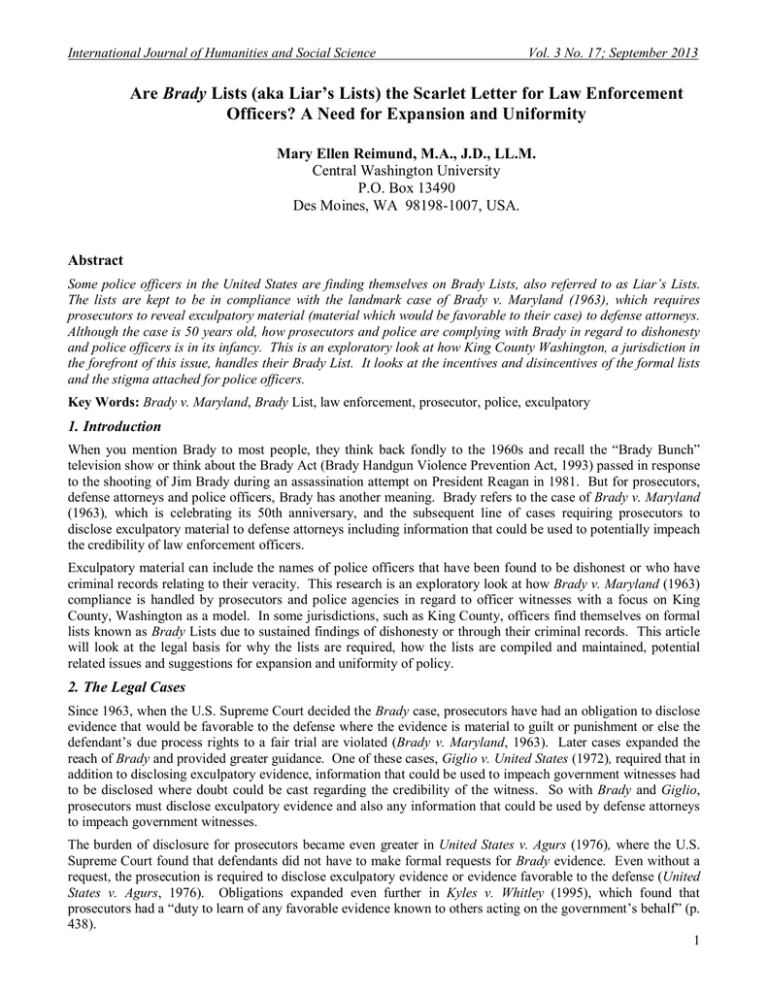Document 10465312
advertisement

International Journal of Humanities and Social Science Vol. 3 No. 17; September 2013 Are Brady Lists (aka Liar’s Lists) the Scarlet Letter for Law Enforcement Officers? A Need for Expansion and Uniformity Mary Ellen Reimund, M.A., J.D., LL.M. Central Washington University P.O. Box 13490 Des Moines, WA 98198-1007, USA. Abstract Some police officers in the United States are finding themselves on Brady Lists, also referred to as Liar’s Lists. The lists are kept to be in compliance with the landmark case of Brady v. Maryland (1963), which requires prosecutors to reveal exculpatory material (material which would be favorable to their case) to defense attorneys. Although the case is 50 years old, how prosecutors and police are complying with Brady in regard to dishonesty and police officers is in its infancy. This is an exploratory look at how King County Washington, a jurisdiction in the forefront of this issue, handles their Brady List. It looks at the incentives and disincentives of the formal lists and the stigma attached for police officers. Key Words: Brady v. Maryland, Brady List, law enforcement, prosecutor, police, exculpatory 1. Introduction When you mention Brady to most people, they think back fondly to the 1960s and recall the “Brady Bunch” television show or think about the Brady Act (Brady Handgun Violence Prevention Act, 1993) passed in response to the shooting of Jim Brady during an assassination attempt on President Reagan in 1981. But for prosecutors, defense attorneys and police officers, Brady has another meaning. Brady refers to the case of Brady v. Maryland (1963), which is celebrating its 50th anniversary, and the subsequent line of cases requiring prosecutors to disclose exculpatory material to defense attorneys including information that could be used to potentially impeach the credibility of law enforcement officers. Exculpatory material can include the names of police officers that have been found to be dishonest or who have criminal records relating to their veracity. This research is an exploratory look at how Brady v. Maryland (1963) compliance is handled by prosecutors and police agencies in regard to officer witnesses with a focus on King County, Washington as a model. In some jurisdictions, such as King County, officers find themselves on formal lists known as Brady Lists due to sustained findings of dishonesty or through their criminal records. This article will look at the legal basis for why the lists are required, how the lists are compiled and maintained, potential related issues and suggestions for expansion and uniformity of policy. 2. The Legal Cases Since 1963, when the U.S. Supreme Court decided the Brady case, prosecutors have had an obligation to disclose evidence that would be favorable to the defense where the evidence is material to guilt or punishment or else the defendant’s due process rights to a fair trial are violated (Brady v. Maryland, 1963). Later cases expanded the reach of Brady and provided greater guidance. One of these cases, Giglio v. United States (1972), required that in addition to disclosing exculpatory evidence, information that could be used to impeach government witnesses had to be disclosed where doubt could be cast regarding the credibility of the witness. So with Brady and Giglio, prosecutors must disclose exculpatory evidence and also any information that could be used by defense attorneys to impeach government witnesses. The burden of disclosure for prosecutors became even greater in United States v. Agurs (1976), where the U.S. Supreme Court found that defendants did not have to make formal requests for Brady evidence. Even without a request, the prosecution is required to disclose exculpatory evidence or evidence favorable to the defense (United States v. Agurs, 1976). Obligations expanded even further in Kyles v. Whitley (1995), which found that prosecutors had a “duty to learn of any favorable evidence known to others acting on the government’s behalf” (p. 438). 1 © Center for Promoting Ideas, USA www.ijhssnet.com The net cast by Kyles captures members of the prosecution team including law enforcement officers: “Prosecutors are deemed to have constructive knowledge of potential impeachment material held by law enforcement agencies with which they work” (Clark, 2011). 3. Formal Brady Lists Although the Brady case is 50 years old, the way that prosecutors and police agencies deal with compliance continues to evolve with the oldest formal lists only dating back to 2002 in Los Angeles County (Van Derbeken, 2010). Some jurisdictions are still developing their processes today, while others are choosing not to develop formal procedures (Clouse, 2012). In some cases, the development of formal lists began with publicized events. The first Brady list in Los Angeles was a result of the Rampart Police scandal (Van Derbeken, 2010). These formal lists go by a variety of names besides the aforementioned Brady List, including the Giglio List, Liar’s List and PID Policy (potential impeachment disclosure). According to Pam Loginsky (personal communication, February 27, 2013), Staff Attorney for the Washington Association of Prosecuting Attorneys, the term PID Policy is the most accurate and less problematic when dealing with police officers. 4. Operational Model: King County Washington In 2007, King County, the largest county in the state of Washington, was the first in the state to develop a formal Brady List. It was modeled after five counties (Los Angeles, Ventura, Santa Barbara, San Diego and San Bernardino) in California that had formal written Brady protocols at the time (D. Clark, personal communication, September 12, 2013). King County has served as a model for other Washington jurisdictions. Given the size of King County, it is not surprising that it was among the first to develop a formal system. In larger jurisdictions, it is difficult for the prosecutor to keep track of officers in cases where disclosure is necessary. In King County, there are approximately 160 prosecutors (D. Clark, personal communication, March 12, 2013). According to Assistant Deputy King County Prosecutor, Dan Clark, with such a large office it is difficult for prosecutors to know all of the potential Brady officers. This challenge is compounded by the fact that there are 39 law enforcement agencies and 3,034 police officers in King County (WASPC, 2012). At any given time in King County, there are 70 to 75 people on the Brady List (D. Clark, personal communication, March 12, 2013). With 3,034 officers in King County, this means about 2.5% are on the Brady List, which gives some perspective as to the number of officers impacted by this designation (WASPC, 2012). In a smaller jurisdiction, officers meeting the Brady criteria would likely be known among the prosecutors and the defense attorneys, so having a more formal system might not be necessary. In King County, to be in compliance with Brady and have uniformity, a computerized system and protocol has been created. When an officer on the Brady List comes up as a witness in a case, the prosecutor on the case automatically gets a notification. The prosecutor then discusses the witness with a member of the Brady Committee and reviews what material is required to be disclosed to the defense. The Brady Committee consists of five Senior Deputy Prosecuting Attorneys led by the Assistant Chief of the Criminal Division (King County Prosecuting Attorney’s Office, 2011). If disclosure is made they then decide if there are appropriate motions that could be made to limit the admissibility of such information before the jury (King County Prosecuting Attorney’s Office, 2011). 5. How Do Officers Get On The List? The list in King County is comprised of “recurring government” witnesses such as police officers, crime lab employees and other government witnesses that will likely testify in future cases (D. Clark, personal communication, March 12, 2013). There are several ways that officers can get on the Brady List in King County: sustained findings of misconduct, criminal convictions and in-court testimony and findings (D. Clark, personal communication, March 12, 2013). For the first category, law enforcement agencies are asked by the prosecutor to provide information on sustained findings of misconduct involving officer dishonesty. These include findings or violations of false verbal or written statements and could range from taking evidence from the scene of a crime to reporting a sick day when they were not ill. Albert and Noble (2009) discuss a continuum in assessing police lies. Their conduct continuum regarding lies ranges from intentional, malicious, and deceptive to lies justified by necessity (Albert & Noble, 2009). Police agencies also are required to provide information to the prosecutor about officers’ criminal convictions to comply with Brady and Washington Criminal Rule on prosecutors’ obligations in discovery 4.7(a)(l)(vi) (any record of prior criminal convictions). 2 International Journal of Humanities and Social Science Vol. 3 No. 17; September 2013 An officer’s conviction for a crime like theft would fit into the Brady category since it would be a reflection on truthfulness as contrasted to an arrest for driving under the influence of alcohol. Information provided by the police agencies to the prosecutor on sustained findings of misconduct involving dishonesty or criminal conviction does not undergo further review by the Brady Committee (King County Prosecuting Attorney’s Office, 2011). The rationale for no additional further review according to Clark (personal communication, March 12, 2013) is because the due process considerations are left to the agency and their disciplinary processes and are not second-guessed by the Prosecutor Office’s Brady Committee. This is the way that most officers get on the Brady List (D. Clark, personal communication, March 12, 2013). The other ways that officers can get on the list are when a deputy prosecutor becomes aware of potential Brady material and writes a memo on the material, which is submitted to the Brady Committee, or a judge has made those findings in a case. After review of the material if proven true by a preponderance of the evidence, the County Attorney’s Office notifies the relevant agency that has discretion whether to notify the officer. The officer and relevant agency can submit a response with additional evidence for the committee’s consideration. After that review, if the committee’s decision remains the same, the agency and officer are notified that the officer will be added to the Brady list (King County Prosecuting Attorney’s Office, 2011). 6. Officers on Brady Lists There are concerns that an officer on the Brady List is tarnished with the scarlet letter of law enforcement. For officers in some departments, being on a Brady List can result in termination (Van Brocklin, 2011). In police circles, there are concerns about there being a group of officers who would be unable to testify. To address these concerns, a pro-union law enforcement group has sponsored legislation in California that would prohibit law enforcement agencies from punishing officers who find themselves on Brady Lists in ways “such as firing, reassigning or denying a promotion” (Gutierrez & Minugh, 2013). Without these protections, officers could form “liar’s squads” within agencies composed of Brady cops whose credibility would be so tarnished that they would not be allowed to be in a position of having to testify (Judge, 2005). Clark attempts to temper the emotional charge attached to Brady Lists. In King County, the protocal states that, “The mere fact that a recurring government witness has been added to the Brady List is not necessarily a comment by the Committee on that individual’s future viability as a witness, on his or her reputation, or on the person’s ability to serve in his or her current capacity” (King County Prosecuting Attorney’s Office, 2011, p. 2). Just because Brady List officer information needs to be turned over to the defense does not mean that it will be admissible in court. The state criminal rule regarding prosecutors’ discovery obligations has provisions for the court to view the information in camera (in private) prior to disclosure (Cr.R. 4.7(b)). Clark (personal communication, March 12, 2013) says efforts can be made by the prosecution to suppress use of the information using the rules of evidence such as Rule 403 where the court determines whether the information comes in weighing the need for the information versus the prejudicial impact on a case-by-case basis. According to Clark (personal communication, March 12, 2013), some agencies have officers on the Brady List that are assigned to positions that would reduce the likelihood that they would testify in court. In other cases, the officer conduct is such that the agency would make efforts to terminate the officer because he or she would be ineffective as a witness because of required Brady disclosures. In a case out of Kitsap County, the sheriff tried to terminate Deputy LaFrance on allegations of misconduct and lying (Kitsap County Deputy Sheriff’s Guild v. Kitsap County, 2009). As a Kitsap County Sheriff’s Deputy, LaFrance was covered by a union contact requiring the county to undergo binding arbitration when terminating an officer. Part of the rationale for the termination by the county was that the prosecutors would have to disclose the officer’s record of dishonesty in any criminal case where he was a witness. The Washington Supreme Court found that even if that were true, “The Brady rule provides neither an explicit nor a well defined public policy against reinstating an officer found to be untruthful” (Kitsap County Deputy Sheriff’s Guild v. Kitsap County, 2009, p. 680). So pursuant to the standard required in arbitration, this did not rise to the level of being a public policy violation and the Washington Supreme Court upheld the arbitrator’s findings that the officer should be reinstated. In response to that court decision, the 2010 Washington Legislature added a provision to the Revised Code of Washington regarding honesty and policing. 3 © Center for Promoting Ideas, USA www.ijhssnet.com “It is the policy of the state of Washington that all commissioned, appointed, and elected law enforcement personnel comply with their oath of office and agency policies regarding the duty to be truthful and honest in the conduct of their official business” (RCW 43.101.021). With that code provision in place, the hiring agency has more authority to terminate an officer for untruthfulness. It is interesting to note that during the legislative hearings police unions testified against the legislation on the grounds that it would be contrary to their bargaining agreements, (Senate Bill Report, 2010) which is reflective of the tension regarding Brady Lists among police agencies and unions. 7. Brady List Inconsistencies One of the issues with the Brady Lists is the variability among counties. King County has well established procedures and standards for compiling and working with their Brady Lists. They are considered the model for other counties in the state developing their protocols. According to Loginsky, it is not known how many county prosecutors in Washington have formal Brady Lists or Potential Impeachment Disclosure List, although all are required to meet the disclosure requirements under Brady. In order to create uniformity in compliance, members of the Washington Association of Prosecuting Attorneys recently adopted a model policy (P. Loginsky, personal communication, September 12, 2013). The policy requires all Washington County deputy attorneys to know and follow the protocol (Washington Association of Prosecuting Attorneys, 2013). The Washington Association of Sheriffs and Police Chiefs are working on a model policy for police agencies that dovetails into the prosecutor’s policy (P. Loginsky, personal communication, September 12, 2013). Those who have encountered issues with county-to-county variations regarding Brady Lists are agencies such as the Washington State Patrol, where officers may cover multiple counties. It could be possible that an officer would be on a Brady List in one county and not in another or even be in a county that does not have a list. This inconsistency is perplexing for the police agencies and is indicative that some prosecutors are in compliance with Brady while others are not. In the past several years, the Washington State Patrol has taken a strong policy stand regarding Brady violations and circulated a memo to all of their officers about Brady and employment indicating that Brady violations may be grounds for termination (Batiste, 2011). The evidence presented suggests that there is a need for consistency regarding Brady policies in prosecutor offices across the state and perhaps even across the country. The issue of inconsistency is being addressed now through a new model policy for county prosecutors in Washington State with a model policy for police under development. Gutierrez and Minugh (2013) report that in California, Sacramento County Sheriff Scott Jones agrees there is a problem with the inconsistency in the way Brady requirements are handled among California’s Counties, but there is “hesitancy to tell district attorneys how to do their jobs.” Legislation in California is first addressing what police agencies can do with Brady information (Gutierrez & Minugh, 2013). Although aspirational, getting uniformity accomplished is perhaps an insurmountable goal for a variety of reasons. There is one Washington case that illustrates the potential problem with an officer suing the county prosecutor who shared information with another county about a Brady List officer who moved to that county. In that case, the court said it “… can find no law prohibiting a prosecutor from sharing potentially exculpatory or impeaching evidence with prosecutors of another jurisdiction” so on that portion of the lawsuit by the officer, the prosecutor was not found civilly liable due to qualified immunity (Lackey v. Golden, 2009, pp. 30-31). Loginsky, who works with county attorneys across the state, says that prosecutors have been sued for damages as was attempted in the Lackey Case and by officers seeking injunctions to try and prohibit the disclosure of Brady information (Bristol, 2012; Doyle v. Lee, 2012). County prosecutors, who have formal lists, can be subject to lawsuits as are the police agencies that have passed along their findings to the prosecutor. In one case in Snohomish County, Washington, an officer who had been put on the list prevailed in his lawsuit to be removed, was reinstated and awarded an $815,000 settlement (Carter, 2009; MacDonald Hoague & Bayless Attorneys and Counselors at Law, 2009). Wender challenged his termination and the issuance of a “Brady Letter” claiming that prosecutors and police command staff had retaliated against him for his free speech and deprived him of his due process rights (MacDonald Hoague & Bayless Attorneys and Counselors at Law, 2009). Without uniformity or sharing of information, it is possible that an officer could be terminated in one county and still work for a department in another county and not be classified as a Brady officer. 4 International Journal of Humanities and Social Science Vol. 3 No. 17; September 2013 8. Advantages and Disadvantages of Formal Brady Lists What would be the incentives or disincentives for prosecutors setting up Brady Lists? Prosecutors are elected officials and there could be political ramifications from having formal Brady Lists since they are not popular among police unions, who supply campaign support and cash (Van Derbeken, 2010). One former prosecutor in California who trains on Brady issues said his colleagues “are not eager to dig into officers’ backgrounds even with the risks of potentially endangering years and years, and possibly hundreds of thousands of convictions” (Van Derbeken, 2010). Some prosecutors take their chances on being found in violation of Brady. There has been much written in legal journals about there being a lack of teeth in enforcing Brady violations (although not specifically addressing Brady Lists per se) suggesting there is not a strong incentive for prosecutors to be in compliance (Jones, 2010; Moore, 2012). But there are greater impacts beyond the political for non-compliance with Brady. Convictions can be reversed, innocent people can be convicted and counties can be subject to civil liability. A recent significant U.S. Supreme Court case that caught the attention of prosecutors involved an inmate who had served 18 years in prison and was within days of being executed, when he won a judgment of $14 million at the appellate level due to the prosecutors’ failure to reveal exculpatory evidence in the case (Connick v. Thompson, 2011). Counties across the country breathed a collective sigh of relief though when the U.S. Supreme Court reversed the judgment, finding that a district attorney’s office could not be liable under §1983 for failure to train its prosecutors based on a single Brady violation. Although the county was off the hook financially, the travesty of injustice that an innocent person had spent 18 years behind bars because of non-disclosure of evidence remained. In King County, Clark does not want his office to be in a position where they would be found on appeal to have been in violation of Brady, along with the professional and ethical implications such as disbarment that such a finding would have. Additionally, he says, there is an access to justice issue when making sure that defendants get the information they are entitled to under Brady. These are the reasons why King County developed their Brady List and continue to emphasize maintaining model policies to ensure compliance. But ultimately, the list is only as good as the information provided by the numerous police agencies in the county and there can be variability in how that is addressed. As for the counties that do not have Brady Lists, P. Loginsky (personal communication, February, 27, 2013) says that perhaps those counties are following the Brady Golden Rule, “if it hurts your case, turn it over; if it really hurts your case, turn it over more quickly.” 9. Conclusion On the 50th anniversary of Brady, it is significant to note that the case’s impact on police officer testimony and veracity is in its infancy. Although there are jurisdictions such as King County Washington that have wellestablished policies, there is still inconsistency statewide and nationwide in how prosecutors handle the requirements of Brady in regard to police officers and variability as to which officers are or are not on the lists. Although the number of officers finding themselves on the Brady List may be a small percentage, it can have a significant impact on the officers’ careers and on the rights of defendants. This paper takes the preliminary steps of outlining some of the issues with Brady Lists and looks at an operational model in King County, which has been at the forefront in the implementation of Brady Lists in Washington State. There is room for further statewide and national review of which jurisdictions have Brady Lists and further development of how prosecutors and police agencies maintain compliance. 5 © Center for Promoting Ideas, USA www.ijhssnet.com References Alpert, P. & Noble, J. (2009, June). Lies, true lies, and conscious deception: Police officers and the truth. Police Quarterly, 12(2), 237-254. Batiste, J. (2011, July 7). Employment consequences of Brady issues and criminal convictions. [Washington state patrol interoffice communication]. Copy in possession of author. Brady Handgun Violence Prevention Act, 18 U.S.C. § 922 (1993). Brady v. Maryland, 373 U.S. 83 (1963). Bristol, C. (2012, October 9). Judge: Officer doesn’t need to pay legal fees. Yakima Herald Republic. Retrieved from http://www.yakimaherald.com/home/394892-8/judge-officer-doesnt-need-to-pay-legal-fees Carter, M. (2009, January 13). $815, 000 Settlement for fired Mountlake Terrace cop. Seattle Times. http://seattletimes.com/html/localnews/2008620842_ copsettled13m.html Clark, D. (2011). Brady. [Training presentation]. Copy in possession of author. Clouse, T. (2012, May 9). Zehm officers on ‘Brady List’: Agencies must identify staff with credibility in question. The Spokesman-Review. Retrieved from http://www.spokesman.com/stories/2012/may/09/zehm-officers-on-bradylist/ Connick v. Thompson, 131 S.Ct. 1350 (2011). Doyle v. Lee, 272 P.3d 256 (Wash. Ct. App. Div. 3 2012). Giglio v. United States, 405 U.S. 150 (1972). Gutierrez, M. & Minugh, K. (2013, September 12). California police unions fight discipline of officers under prosecutors’ lists. Sacramento Bee. Retrieved from http://www.sacbee.com/2013/09/12/5728305/californiapolice-unions-fight.html Jones, C. (2010, Spring). A reason to doubt: The suppression of evidence and the inference of innocence. Journal of Criminal Law and Criminology, (100), 415-474. Judge, L. (2005, November). Disclosing officer untruthfulness to the defense: Is a liars squad coming to your town? The Police Chief, (72)11. Retrieved from http://www.policechiefmagazine.org/magazine/index.cfm?fuseaction=display_arch&article_id=744&issue_id= 112005 King County Prosecuting Attorney’s Office (2011, Feb. 15). Brady committee protocol. King County Archives, King County, WA. Kitsap County Deputy Sheriff’s Guild v. Kitsap County, 219 P.3d 675 (2009). Kyles v. Whitley, 514 U.S. 419 (1995). Lackey v. Golden, 2009 U.S. Dist. LEXIS 94674 (W.D. Wash. October, 9, 2009). MacDonald Hoague & Bayless Attorneys and Counselors at Law. (2009, Jan. 12). Fired Mountlake Terrace police sergeant who criticized drug war reaches $812, 500 settlement with municipalities. [Press Release]. Retrieved from http://www.mhb.com/web_documents/wenderpressrelease.pdf Moore, J. (2012, Summer). Democracy and Criminal Discovery Reform: After Connick and Gracetti. Brooklyn Law Review, (77), 1329-1388. Revised Code of Washington (RCW) 43.101.021 Senate Bill Report, SB 6590. (2010, February 5). Retrieved from http://apps.leg.wa.gov/ documents/billdocs/200910/Pdf/Bill%20Reports/Senate/6590%20SBA%20JUD%2010.pdf United States v. Agurs, 427 U.S. 97 (1976). United States v. Bagley, 473 U.S. 667 (1985). Van Brocklin, V. (2010, August 16). Brady v. Md can get you fired and a $$$ judgment against you. Police.com. Retrieved from http://www.officer.com/article/ 10232477/brady-v-md-can-get-you-fired Van Derbeken, J. (2010, May 16). Police with problems are a problem for D.A. San Francisco Chronicle. Retrieved from http://www.sfgate.com/bayarea/article/ Police-with-problems-are-a-problem-for-D-A-3264681.php Washington Association of Prosecuting Attorneys. (2013). Disclosure of potential impeachment evidence for recurring investigative or professional witnesses. [Policy Document]. Retrieved from http://www.waprosecutors.org /docs/2013PIDdraft-PDF.pdf Washington Association of Sheriffs and Police Chiefs (WASPC). (2012). Washington state full-time law enforcement employee count: 2007-2010 Full time law enforcement employees. [Data file]. Retrieved from http://www.waspc.org/ index.php?c=crime%20statistics Washington Criminal Rule 4.7 Washington Evidence Rule 403 6





